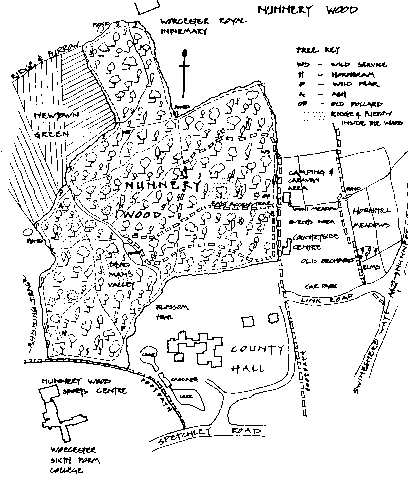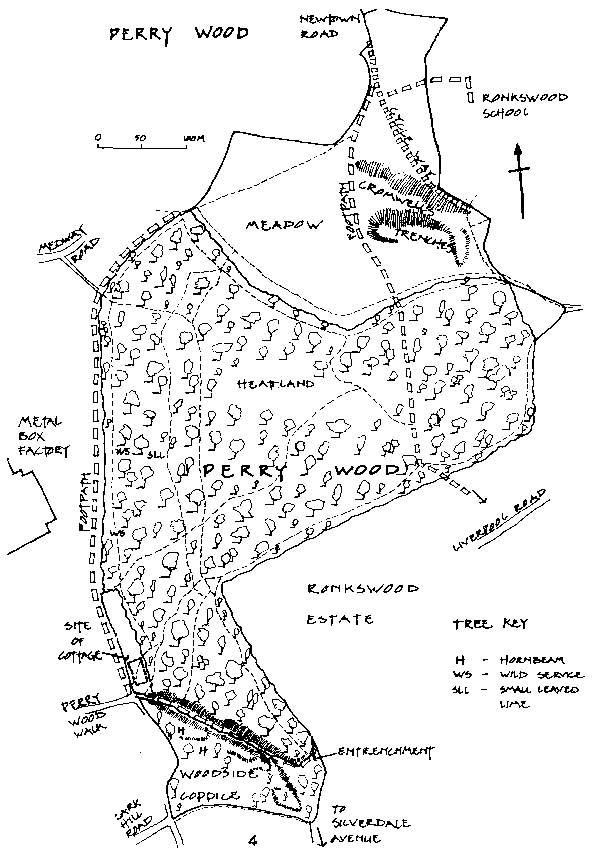
| Home | Credits | Woodland | History | The Year Round | Species | Bibliography | Maps |
Exploring Worcester Woods: the Country Park
Nick Cripps


| Home | Credits | Woodland | History | The Year Round | Species | Bibliography | Maps |

Worcester Woods are unique. They are the living heritage of the City of Worcester and its people. The quartet of woods, Perry, Warndon, Tolladine, and Nunnery Wood, with the adjoining Hornhill Meadows, cover 52 hectares, and together make up the Worcester Woods Country Park.
The four woods are a sanctuary for wildlife and are thickly wooded with oaks which have grown continuously on this same site for centuries. They are exceptional public amenities whose welfare lies with the Hereford & Worcester Countryside Service, based at County Hall, Worcester.
The Countryside Centre, behind County Hall, was opened in July 1987. Furbished with a lecture room, toilets, and cafe it is the focus of many indoor and outdoor events and currently accommodates more than 300,000 visitors a year. Outdoor activities include, guided bird-watching, fungal forays, orienteering, dog training, and for the youngsters - a junior rangers club. Nunnery Wood is especially popular with schools for educational field trips. So pick up an event sheet for details.
Ample parking and cycle provision is provided at the Countryside Centre with access directly from the City's Eastern Orbital Link Road, (A422) named Nunnery Way. There are also footpath routes, bridle ways and cycle tracks. The Countryside Centre at Nunnery is the site recommended for the disabled visitor.

NUNNERY WOOD at 21 hectares is thought to have once been joined to Perry Wood. Its present shape has changed little since 1790. Nunnery Wood has clearly defined hedge boundaries, with a broad bank and ditch on its eastern flank. The wild service tree, cherry, pear and crab apple - a leftover from a possible orchard - all occur mainly along the wood edge. Hornhill Meadows and the ornamental pools of County Hall, greatly contribute to its value as a wildlife site. PERRY WOOD lies on a ridge overlooking the City and, in contrast to Nunnery Wood, is virtually enclosed by urban development. Medieval documents suggest that the wood was more extensive to the northeast, possibly extending up to Trotshill Lane, in Warndon villages. Today it still retains a broad bank-and-ditch along its northern edge. Perry's 12 hectares are heavily used by the public as a walk-through and adventure playground.
PERRY WOOD lies on a ridge overlooking the City and, in contrast to Nunnery Wood, is virtually enclosed by urban development. Medieval documents suggest that the wood was more extensive to the northeast, possibly extending up to Trotshill Lane, in Warndon villages. Today it still retains a broad bank-and-ditch along its northern edge. Perry's 12 hectares are heavily used by the public as a walk-through and adventure playground.
WARNDON WOOD abuts onto the M5 Motorway built in the late 1950's. Its six hectares lie east of a gently sloping ridge which runs from Trotshill in the south to Warndon's St. Nicholas Church and Manor House in the north. Warndon Wood had been neglected for many decades, until coppicing was reintroduced in 1990. An adjacent meadow ‘Stock Coppice' has been partially replanted with trees.
TOLLADINE WOOD at three hectares is enclosed by Warndon villages. In 1991 a footpath and 100m wide replanted strip of woodland has recently 'rejoined' Tolladine to Warndon Wood. Roughly triangular in shape, Tolladine Wood contains a small pond and a circular woodchip pathway to guide visitors.
WOODLAND MANAGEMENT The primary aim of the Country Park is to conserve and enhance the ecological and landscape qualities of the area. Nature conservation is paramount. The Park also carefully balances the needs for recreation and education, and protects any features and sites of historical and archaeological interest.
COPPICING is a form of woodland management, which has the benefit of putting ‘life’ back into tired, neglected woods. In practice coppicing involves clearing a glade by removing bramble, hazel understorey and felling a proportion of the larger trees. Each year new glades are formed. After a cycle of 20 years or so, the entire wood has been managed. Each coppiced area being in a differing state of regeneration provides a variety wildlife habitats. For wildlife and wildflowers the coppicing cycle is of enormous benefit.
After coppicing the felled timber can be sold. Remaining trunks and branches are logged and piled to provide habitats for beetles and weevils. Any brush wood is heaped inside the glades as shelter for small mammals, shrews, mice and voles.
Work parties are frequently organised to help with conservation work. Contact the Worcester Woods' Rangers, The British Trust for Conservation Volunteers (BTCV), or see the activities sheet in the Countryside Centre for details.
Copyright © 2001
Nick Cripps
Photographs Copyright © 2001 Neil Harris
Portraits Copyright © 2001 Nick Upton
Web Design Copyright © 2001 John Stafford

Worcester Woods Title Page
Help Create WHE
Worcestershire History Encyclopaedia